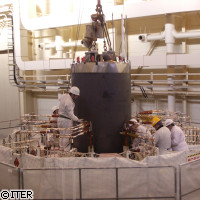Nuclear fusion research takes a step forward
Europe, Japan and the ITER organisation have achieved a landmark success in their quest to create a nuclear-fusion-powered reactor. Fusion for Energy (F4E), with the support of the European Commission, the Japan Atomic Energy Agency (JAEA) and the ITER Organisation, has successfully tested a prototype superconductor for a major component of the ITER project. ITER, the world's largest experimental fusion facility, is based in the south of France and aims to harness energy produced by nuclear fusion to provide an abundant source of power that is safe, environmentally responsible and economically viable. Nuclear fusion, or the joining of small nuclei to make a larger nucleus, is an energy-producing process that occurs naturally in stars. Nuclear fusion creates considerably more energy and less radioactive material than nuclear fission, and generates millions of times more energy than the burning of coal. Since the 1950s, researchers have been trying to control fusion power in a contained space in order to generate electricity. In nuclear fusion, ions are mixed with electrons and a plasma is formed. One of the challenges of controlling nuclear fusion is confining and igniting this plasma in a self-sustaining way. ITER is an international experiment using a tokamak, or a machine producing a 'toroidal' magnetic field for confining the plasma. The components of ITER are manufactured by each of the participating countries. One major component is a set of 'poloidal field coils,' which are used to maintain plasma equilibrium. The coils are made of titanium and niobium, and shape the inside of the reactor. The coil system comprises a central coil and seven ring coils, wound from a large 'cable-in-conduit' conductor and covered by a stainless-steel jacket. Together they should provide magnetic fields that confine the plasma and control its position, as well as contributing to the magnetic 'flux change' that ramps up and maintains the plasma current. The prototype is 1.5m in diameter and weighs 6 tonnes, and came out of a collaboration between Russia, Europe and Japan. Russian researchers made the superconducting strands that went into the coils, and European researchers put the jacket on and wound the conductor. The coil was tested at the Japan Atomic Energy Agency site in Naka, Japan with expert representation from ITER, Europe, Japan, Russia and the United States. The recent test of the coil-system prototype was successful in that the coils reached a stable operation at 52kA in a 6.3-Tesla magnetic field. This indicates that the design of the prototype is appropriate to the demands that will be placed on it. The success represents a major milestone in fusion research, as the project can move on to procuring the next component: poloidal field conductors. ITER is one of the world's most expensive scientific projects, and the EU will contribute almost half of the costs of construction. The rest will be funded equally by China, India, Japan, the Republic of Korea, Russia and the United States. The EU's financial contribution comes almost entirely from the Euratom budget. The ITER project is scheduled to last for 30 years. One of the objectives of the project is to conduct its first plasma operation in 2018, and produce a full-scale power plant by 2050. Fusion for Energy, a 35-year joint undertaking established in April 2007, seeks to reinforce Europe's position as a world leader in the development of fusion energy. The technology provides hope that our growing global energy needs can be met without producing climate-changing greenhouse gases.



